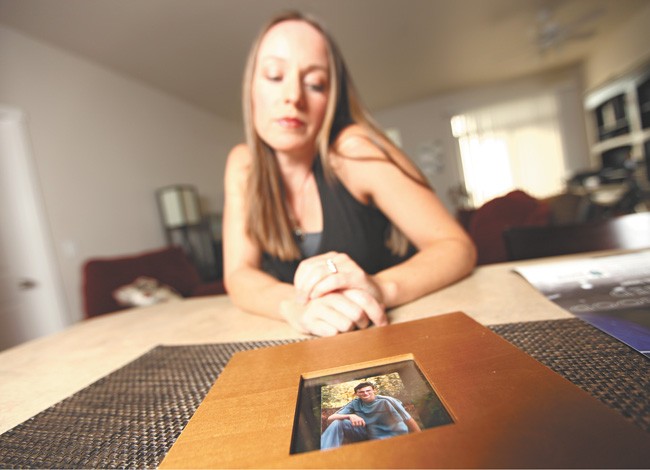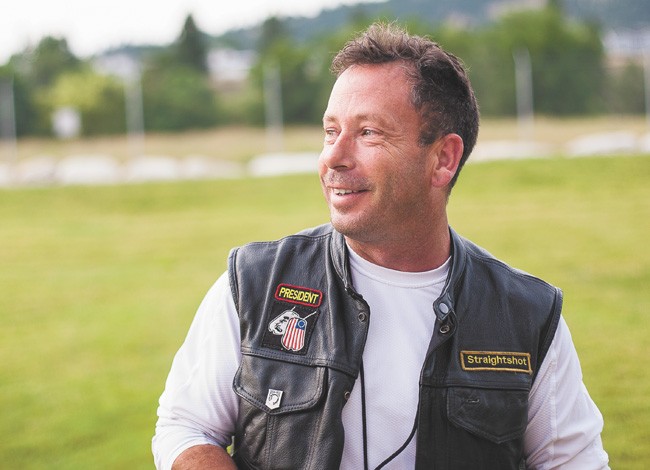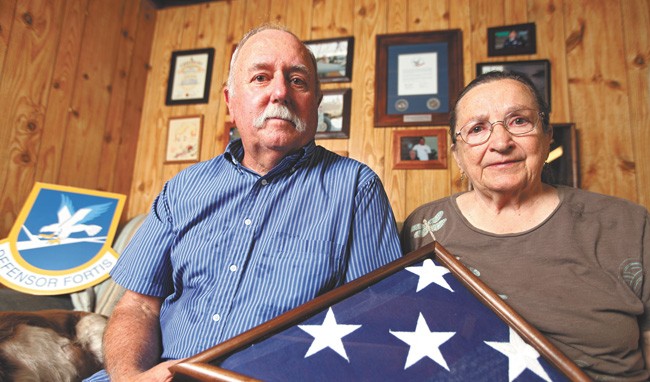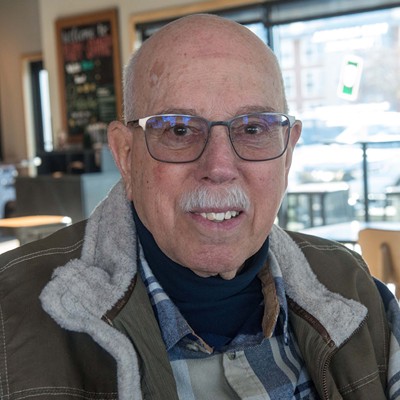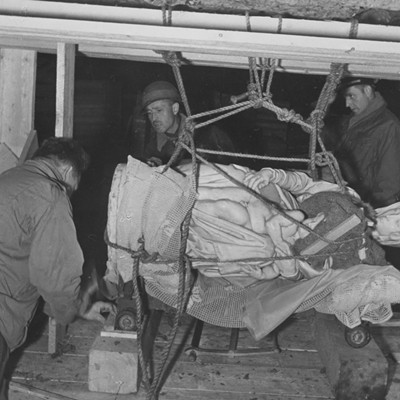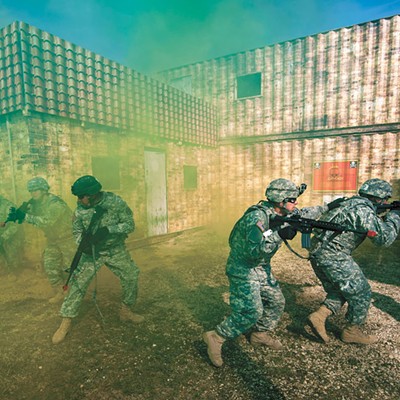As his loved ones dashed to their cars and the police fielded 911 calls about a despondent man at a cemetery, Ed Pace sat on a bluff overlooking the Spokane River, an iPhone and a Smith &Wesson .44-caliber pistol in his hands.
“We were all too late,” says his father, Bob Pace, who raced from a business trip in Idaho back to Spokane in hopes of finding his son alive. “He made up his mind.”
At what point did Ed Pace, a 44-year-old foundry worker and member of the Washington Air National Guard, decide there was nothing left for him? Was it earlier in the day when he came to his parents’ house in Edwall, passing through the living room to see his stepmother?
“He was in a good mood,” recalls Loyce Pace. “He just put his hand on my shoulder when he went and said, ‘Have a good day, Mom.’”
Was it four weeks earlier, when he had committed himself to the Spokane Veteran Affairs Medical Center, saying he was thinking about killing himself, before being discharged after one week?
Was it in 2005 when he had come back from Iraq with three coins - awards for valor from his comrades - but also having lost two close friends?
There’s no way to tell.
Ed Pace had mentioned to his parents that he liked the Fort George Wright Cemetery on Government Way, with its perfect grass and orderly tombstones. From its spot, on the western flank of the city, there is a view across the Spokane River as it bends north. Beyond it are the neighborhoods of northwest Spokane, where the VA Medical Center stands out above the houses.
On that cloudy, warm afternoon on June 16, Ed Pace went to the veterans cemetery and called his girlfriend, who had recently asked him to move out. He also texted his father.
“He just couldn’t go on any longer, he couldn’t deal with it, he couldn’t go on, he loved us all, he’d hurt too many people,” Bob Pace says, recalling his son’s text message.
Neither Pace’s girlfriend nor his father would arrive in time.
But in the grim statistical logic of suicide, it’s unlikely that Ed Pace was alone that day. The VA estimates a veteran takes his or her life every 80 minutes.
Among active-duty soldiers, the numbers are also troubling. This year, the Associated Press reported that 154 active-duty soldiers killed themselves in the first 155 days of the year - more than were lost to combat in the same time. Another Department of Defense study estimates that among active-duty soldiers, the rate of suicide is one every 36 hours.
U.S. combat in Iraq is over and the war in Afghanistan is supposed to end by 2014. Yet another war still rages, one that has neither congressional approval, nor battle lines or a withdrawal date.
In this fight are war veterans and their inner demons. Their skirmishes play out in homes and workplaces, in VA hospitals and military barracks. Be it post-traumatic stress disorder, traumatic brain injury or suicide, many soldiers who served overseas return home to find that this new war is waiting for them.
“When you’re losing more people than are being killed over there,” Bob Pace says, “there’s something wrong.”
Left Behind
The trailer behind his father’s house where Ed Pace stored some of his things - uniforms and collectibles - has been picked over by Air Force investigators. But you can still find traces of Pace in three boxes in his father’s tool-filled garage: mostly NASCAR paraphernalia, and lots of it, some of it still unopened in boxes.
“The first place [Ed would] hit was the NASCAR track,” recalls Bob Pace. When Ed was stationed in Texas, right before going to Iraq, he went to races there; for vacations, he’d head to the speedway in Las Vegas.
His son liked the outdoors. When Ed was home, the two of them would go fishing together at Sprague Lake.
But above all, Ed Pace liked the military. He wanted to serve his country, as his father had in the Army.
Ed Pace joined the Army during the first Gulf War but had a head injury that sidelined him for several years. Around 2001, his father says, Pace joined the Idaho Army National Guard, where in 2004 he went to Iraq. A stint with the Idaho Air National Guard, which he joined around 2007, took him to Afghanistan. He spent three months building bombs there.
The deployments took their toll on Pace, his father says. They destroyed two marriages, one of which ended with a dreaded “Dear John” letter from his wife that awaited him on his return home.
And the Ed Pace who came back from Iraq was a changed man.
“Noises bothered him,” his father recalls. He stopped sleeping soundly. But his son “could put on the face for the Air Force - he gave you what you wanted to hear.” Pace pushed through it, leaving the Idaho Army National Guard and joining the Washington Air National Guard’s 141st Air Wing Security Forces. He’d always liked law enforcement, his father says, and was slated to deploy again as military police in a few months.
But then he told his father that he was thinking of killing himself. Pace checked himself into the Spokane VA and was there for a week before they released him.
When a soldier comes in complaining of having suicidal thoughts, the VA “throws a lot of resources at them,” says Quinn Bastian, chief of the Spokane VA’s behavioral health unit.
“We know that one period of high risk for anybody is after a period of psychiatric hospitalization,” Bastian says. Though not all veterans who receive hospitalization are considered high-risk, Bastian says there are typically between 40 and 80 veterans in Spokane in that category. After inpatients are discharged, psychologists schedule weekly follow-up appointments with them, prescribe medication and track them for changes in behavior.
And yet, there is only so much the VA can do, Bastian says. Thirty veterans under the care of the Spokane VA have taken their lives since 2008, according to Bastian. The numbers peaked between July 2007 and July 2008, when 14 completed suicide.
So far this year, three people who have received care from the hospital died by suicide, Bastian says.
“The more that people go to war, the more they’re going to struggle with mental health problems,” Bastian says. “As long as people are exposed to traumatic circumstances, there will be traumatic injuries.”
When his son left the hospital, Bob Pace says he acted fine, the same as always. He doesn’t know if they gave him any drugs, but the doctors did scheduled follow-up appointments for him. As far as he knew, his son was going to the appointments when was supposed to.
Three weeks after he was discharged from the VA, though, Ed Pace was dead.
Shell Shock
They called it “soldier’s heart” in the Civil War, then later on the 19th century “railway spine.” By World War I, it was “shell shock” or “war nerves,” then “combat fatigue” in World War II.
“Greek tragedies have talked about people after war” dealing with stress, says Rajeev Ramchand, associate director of military health policy research for the RAND Corporation, a nonprofit think tank.
By the early 1980s, it was called PTSD. Nowadays, about 15 to 20 percent of veterans have it, Ramchand says. It’s haunted generations before that: Ramchand estimates the rate among Vietnam veterans was between 15 and 30 percent.
How it manifests itself in veterans of Iraq and Afghanistan shows the unique character of those wars.
With its sheer size, the U.S. military can outgun most of its opponents around the globe, including the Taliban in Afghanistan and the insurgents in Iraq. But that’s if the enemy fights a conventional war with conventional rules, says Duane Hardesty, a former Army colonel who now works on a reintegration program for injured veterans run by defense contractor Northtrop Grumman.
“The kind of war we’re fighting in Afghanistan and other places is called ‘asymmetrical,’” he says. Its hallmarks are improvised explosive devices, suicide bombs and, increasingly in Afghanistan, “green-on-blue attacks,” where Afghan soldiers turn their weapons on Americans. “In an asymmetrical environment, you have to understand [that] as a warrior, there is no safe place.”
That creates an atmosphere of fear, says Lt. Col. Todd Plotner, a professor in Washington State University’s military science department. Shootouts or bomb blasts can happen at any time, and the people trying to kill you can be who you least expect.
“There is no safe zone within the conflict,” Plotner says. “We are, in Iraq and Afghanistan, dealing with enemies who are employing terrorist tactics and generally trying to look like the civilian population.”
Ramchand says the determining factor for PTSD is whether someone experiences combat. And asymmetrical warfare brings combat everywhere.
“Where there’s lots of combat is where you’ll find the PTSD,” Ramchand says. Combat experience is not restricted to shootouts: the smell of burning flesh, seeing someone who is injured or dead, or even just knowing someone who was killed or maimed can induce PTSD.
“[A soldier] doesn’t necessarily [need to be] perpetrating a violent event, nor does it need to be seeing incoming fire. It could be any of these things,” Ramchand says.
Having PTSD often means a soldier can’t turn off their battlefield sense, he says. People with the disorder can suffer flashbacks from war, or feel hyper-vigilant.
“The symptoms of PTSD can be things that are very useful on the battlefields. It’s just that when someone comes home, they tend to interfere with their day-to-day lives.”
But whether PTSD leads directly to suicide is difficult to correlate.
“We’re kind of in a Catch 22 in that [with] the majority of people who die by suicide, there’s evidence that they have a mental health disorder,” Ramchand says. “At the same end, very few who have a mental health disorder will die by suicide.” Statistics show that rate is about three percent of all people with a mental disorder, Ramchand says.
Instead, PTSD can be one of a number of disorders afflicting someone who completes suicide, says Anna Marie Medina, an assistant professor of psychology at Gonzaga University.
“Having PTSD is certainly correlated with a horrible quality of life, unless you get help with it,” Medina says. But so is traumatic brain injury, which many soldiers suffer in combat, though their injuries often go undiagnosed. But being diagnosed with PTSD doesn’t mean a veteran is at risk for suicide.
“You’ve got a lot of people who kill themselves but don’t meet the criteria for PTSD,” Medina says.
Mind Field
Something about the way the light glowed in the distance stuck with Taylor Wilkening. As a petty officer second class on the aircraft carrier U.S.S. Carl Vinson, it was his job to help planes take off and land as they flew missions over Iraq.
“I can’t be specific as far as where the birds went. I know they didn’t come back with the ordinance,” says Wilkening, 28.
He watched from the carrier’s deck as the lights pulsed across the Persian Gulf.
“To be frank, we lit that place up. I mean you could see it,” he remembers. “I kind of brought that home with me.”
Not all planes returned from their missions. Two Marine pilots died during the deployment, their F/A-18 Super Hornets never returning from the skies above Iraq.
Wilkening made it home, and when he left the Navy in 2008, money from the G.I. Bill was there to take him through a business program at Spokane Falls Community College. So was Pinnacle vodka.
“I drank vodka like water,” as in a bottle a day, says Wilkening. “It might sound tough to people who never drank excessively, but to me it was quite normal.”
And his favorite thing to do when he was drunk was drive. The two were inseparable, Wilkening says. One led to the other; both helped him dim the lights flashing in the Middle East night that somehow still played in his head.
He had his first driving-under-the-influence arrest right before graduation. Another would follow. He managed to graduate and started to send out job applications to employers who never called back.
Veterans, particularly of post-9/11 wars, are often the most susceptible to unemployment, according to the Bureau of Labor Statistics. The unemployment rate for those veterans was 12.1 percent in a March report. For men between the ages of 18 and 24, the rate was 29.1 percent.
Alcohol abuse, too, is prevalent among soldiers. According to a study by the National Alliance on Mental Illness, one in five active-duty members engaged in binge drinking. Another study of Army soldiers screened three to four months after serving in Iraq showed that 27 percent showed symptoms of alcohol abuse.
“It’s what people do when they don’t know how to manage,” says Medina. “These guys can’t relax. You’ve trained your body for seven months to 13 months to be hyper-vigilant. You’re not just going to unwind.”
Wilkening eventually went for treatment at the VA, receiving a diagnosis of PTSD. For his DUI arrests, the court ordered him to attend the Spokane Veterans Forum, a monthly program that brings veterans together to help them work through their problems.
“It was only a few months ago that I was able to look back at what I was doing and realize that it was just out of control,” Wilkening says.
Four years after getting back, Wilkening found a job: working at his mother’s farm near Davenport, where their annual harvest of barley and wheat will happen in the next few weeks.
Others never made it that far.
Soldiering On
Chris Dana called them “daymares.”
They started a month after he came home from Iraq in 2005, flashbacks that would plague him.
“[He] never would say what he would see,” says Matt Kuntz, his stepbrother. “He was self-isolating, and I just thought he didn’t want to hang out with me.”
His family pushed him to get to counseling, but Dana refused. He chose to deal with it on his own, stepsister Janna Sherrill says.
“He thought that was part of what every soldier encountered when he returned home and that he needed to just buck up and deal with it,” Sherrill says.
He held jobs and tried to keep it together, not wanting to tell his employers that he was in the National Guard, she says. And he certainly didn’t go to the VA or want to have to face his bosses if he got diagnosed with PTSD.
“He was avoiding it,” Sherrill says. “He thought he could handle it.”
It was that way for a year and a half. Then, when the Guard called him and he didn’t show up in 2007, they gave him a less-than-honorable discharge.
“Just being back in a military environment was enough to cause him severe panic attacks,” Kuntz says. “He was just too hurt to be able to do the military things that they wanted him to do.”
In early March 2007, Dana shot himself.
His death transformed his family. Kuntz, his stepbrother, left his job as an attorney to join NAMI’s Montana chapter, and push for a more thorough screening of veterans.
Previously, screening consisted of what Kuntz characterized as a brief conversation with a counselor - and no more.
“Chris was screened for PTSD on his initial return, and he told me that he laughed about it,” Sherrill says. “He indicated that he wasn’t impressed, that it was a joke, that he hadn’t found it to be very helpful for him.”
Kuntz lobbied Congress for a change in the military screening process, which was later incorporated in a national defense authorization bill. It was successful; soldiers are now screened for PTSD before they deploy, then at intervals of six months, a year and two years afterwards, Kuntz says.
But the larger issue, Kuntz says, is addressing the culture of soldiers who won’t get counseling, no matter what.
“In the military, there’s a stigma against all injuries. Everybody fights to stay healthy or fights to not go to the doctor,” says Kuntz, an Army veteran himself. “They needed more proactive screening for PTSD because the military culture is just not one where people volunteer to go get medical treatment.”
After Dana’s death, Sherrill took action as well. An occupational therapist who recently moved to Liberty Lake, she started Xsports4vets, a program where military veterans get together to connect in the outdoors. It’s an informal program for getting veterans to open up to each other, Sherrill says. So far, Sherrill estimates that about 100 veterans have participated in the program since 2010.
“There’s a lot of distrust of organizations among veterans, and I found that Xsports service was ideal to get them,” Sherrill says. “It wasn’t that there wasn’t support services available to my stepbrother. We just couldn’t get him to them.”
Support and camaraderie is what Combat Vet Riders, a motorcycle club for veterans, is all about. The group was started mostly to help Vietnam veterans pull through together and has picked up membership from those who served in the Gulf War and the post-9/11 conflicts.
At a monthly meeting of the Riders, leather is ubiquitous, as is the flag. There’s a big Stars and Stripes on the wall, which the group of 100 some vets and their families turn and pledge allegiance to before the meeting starts.
Eric Cockrill is the current president, and the former tank crewman who served in the Gulf War says he finds solace on a motorcycle.
“Your attention is on the road. Your attention is on your surroundings, it’s on escape,” Cockrill says.
Riding the Palouse or the backroads of North Idaho takes his mind off things.
“We all understand why we can all be a little quirky,” Cockrill says. “We’re all a little fractured, and we all understand that.”
Culture Change
The show-no-weakness culture of the military again came under scrutiny earlier this year. In a controversial blog post, Army Maj. Gen. Dana Pittard called suicide a “selfish act.”
“I’m personally fed up with soldiers who are choosing to take their own lives so that others can clean up their mess,” Pittard wrote. “Be an adult, act like an adult, and deal with your real-life problems like the rest of us.”
Pittard later retracted that statement.
Plotner, the military science professor, says the Army’s been trying to change the culture in favor of getting help, particularly when it comes to inducting new recruits.
“We rightly use terms like ‘strength’ and ‘resilience’ in describing characteristics we recruit and train in our leaders. However, human nature tends to interpret those traits as though ‘strong leaders don’t need help,’” Plotner says. Commanders are more open about their own struggles now. “By gradually changing the culture, so that leaders set the example by seeking help when they recognize the signs of stress in themselves, we can go a long way to resolving combat-stress symptoms before they become debilitating.”
Additionally, policymakers are shining a spotlight on how the military diagnoses PTSD, which has lately been marred by scandal.
In March, Washington Democratic Sen. Patty Murray accused Madigan Army Medical Center in Tacoma of reversing PTSD diagnoses of active-duty soldiers, saying a team there either turned down PTSD diagnoses or, worse, alleged the soldiers were lying.
Secretary of Defense Leon Panetta, in a June hearing before the Senate Appropriations Committee, announced that the entire military would be reviewing diagnoses of PTSD.
“There are still huge gaps in terms of the differences of how they approach these cases and how they diagnose the cases and how they deal with them, and frankly, that’s a whole area we have to do much better on,” Panetta told the committee.
Also in June, Murray introduced the Mental Health ACCESS Act of 2012, which would standardize the Department of Defense’s approach to combating suicide, extend VA services to spouses of veterans and regulate training for medical providers.
“The Department of Defense and the VA are losing the battle against the mental and behavioral wounds of these wars,” Murray told the Senate when she introduced the bill.
But Lt. Col. Kurt Shevalier, deputy state surgeon for the Washington Army National Guard, says improving services is only one part of the equation. The military can offer all the counseling they want. Getting the soldiers who need it to show up is another matter.
“The other part of it that I think has always been out there too is the kind of stigma stuff. That’s an ongoing battle,” Shevalier says. “‘I’m not good enough, my unit’s not going to like me, I’m letting my friends down.’ They probably experience some kind of thoughts along those lines.”
Memory and Hindsight
Ed Pace didn’t live with his parents when he died, but their house is filled with memories of him. Among his father’s amateur gunsmith setup downstairs are boxes of files containing the military’s entire documentation of his son’s service. Another envelope contains his medals, including the Purple Heart and a Combat Action Badge for fighting in Iraq.
Last week, Bob Pace took a trip out to Fairchild Air Force Base to get the last few of his son’s belongings, including the coins that his son was so proud of, found with him at the cemetery. And in his quiet, dark basement is a whole wall covered in pictures of his son in the service, with photos of him sitting before a huge bomb in Afghanistan or standing in camouflage before a military truck.
“No one knew what you were going through,” reads a poem handwritten by his former colleagues, displayed on the back of a unit insignia framed on white cardboard. “We only kept on seeing what we really wanted to.”
Investigators have come and gone from the house, interviewing the family, and a grief counselor from the Air Force referred Bob Pace to a program for families who have lost loved ones in the war.
The elder Pace says he doesn’t blame the VA for his son’s death, but he has been writing letters to his senators and congresswoman, asking that soldiers, be they retired or active-duty, be offered more services for their struggles after war.
“You find out more in hindsight than you do in foresight,” he says.
His son has a gravesite down at the veteran’s cemetery in Medical Lake. Bob Pace plans to go see him, as soon as his son gets a gravestone.
How You Can Help Someone
If you know someone whom you think may be suicidal, show that you care by:
Listening to them with sincere concern for their feelings. Do not offer advice, but let them know that they are not alone.
Sharing your feelings with them. If you feel that they may make a reckless decision, tell them that you are concerned. They need to know that they are important to you and that you care.
Inquiring if they have had suicidal thoughts or if they have made a suicide plan in a straightforward and caring manner. If you feel you cannot ask the question, find someone who can.
Call the National Suicide Prevention Lifeline: 1-800-273-TALK (8255) or First Call for Help Crisis Hotline: 509-838-4428.
SOURCE: National Suicide Prevention Lifeline,
suicidepreventionlifeline.org
Warning Signs
Talking or writing about death, dying or suicide when these actions are out of the ordinary for the person
Acting reckless or engaging in risky activities - seemingly without thinking
Increasing alcohol or drug use
Withdrawing from friends, family and society
Feeling anxious or agitated, being unable to sleep, or sleeping all the time
Experiencing dramatic mood changes
Changes in eating and sleeping habits
Unusual neglect of personal appearance
Marked personality changes
Frequent complaints about physical symptoms, often related to emotions, such as stomachaches, headaches, fatigue, etc.
SOURCES: National Suicide Prevention Lifeline (suicidepreventionlifeline.org); National Alliance on Mental Illness (nami.org)



